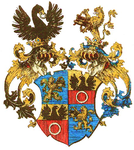
Nuremberg is the second-largest city of the German state of Bavaria after its capital Munich, and its 518,370 (2019) inhabitants make it the 14th-largest city in Germany. On the Pegnitz River and the Rhine–Main–Danube Canal, it lies in the Bavarian administrative region of Middle Franconia, and is the largest city and the unofficial capital of Franconia. Nuremberg forms a continuous conurbation with the neighbouring cities of Fürth, Erlangen and Schwabach with a total population of 800,376 (2019), while the larger Nuremberg Metropolitan Region has approximately 3.6 million inhabitants. The city lies about 170 kilometres (110 mi) north of Munich. It is the largest city in the East Franconian dialect area, Nuremberg was one of the host cities of the 2006 FIFA World Cup.

Sas or Szász is a Central European coat of arms. It was borne since the medieval period by several Transylvanian-Saxon Hungarian, Ruthenian, Ukrainian, and Polish-Lithuanian noble families. The house was once a mighty princely and ducal house with origins in Saxony, Transylvania, Hungary and Ruthenia.
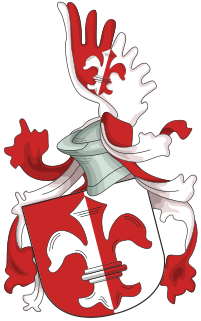
Welser was a German banking and merchant family, a slave trading empire, originally a patrician family from Augsburg, that rose to great prominence in international high finance in the 16th century as bankers to the Habsburgs and financiers of Charles V, Holy Roman Emperor. Along with the Fugger family, the Welser family controlled large sectors of the European economy, and accumulated enormous wealth through trade and the German colonization of the Americas. The family received colonial rights of the Province of Venezuela from Charles V, who was also King of Spain, in 1528, becoming owners and rulers of the South American colony of Klein-Venedig, but were deprived of their rule in 1546. Philippine Welser (1527–1580), famed for both her learning and her beauty, was married to Archduke Ferdinand, Emperor Ferdinand I's son.

Keltren is a municipality in the district of Enz in Baden-Württemberg in Germany.
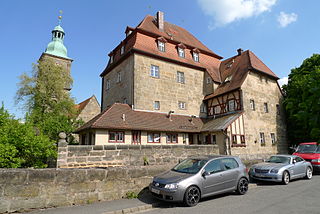
Kalchreuth is a municipality in the district of Erlangen-Höchstadt, in Bavaria, Germany. It is located 10 kilometers east of Erlangen and 15 kilometers north of Nuremberg and contains the villages of Kalchreuth, Käswasser and Röckenhof and also the hamlets of Stettenberg, Minderleinsmühle and Gabermühle.
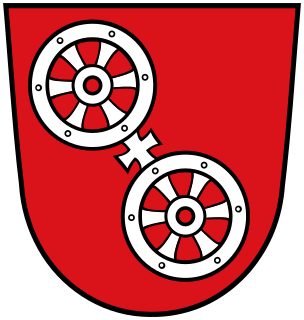
The Wheel of Mainz or Mainzer Rad, in German, was the coat of arms of the Archbishopric of Mainz and thus also of the Electorate of Mainz (Kurmainz), in Rhineland-Palatinate, Germany. It consists of a silver wheel with six spokes on a red background. The wheel can also be found in stonemasons' carvings and similar objects. Currently, the City of Mainz uses a double wheel connected by a silver cross.

Anton Koberger was the German goldsmith, printer and publisher who printed and published the Nuremberg Chronicle, a landmark of incunabula, and was a successful bookseller of works from other printers. In 1470 he established the first printing house in Nuremberg. Koberger was the godfather of Albrecht Dürer, whose family lived on the same street.
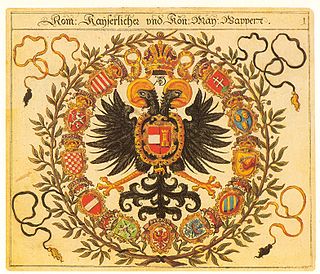
Siebmachers Wappenbuch is a roll of arms first published in 1605 as two heraldic multivolume book series of armorial bearings or coats of arms of the nobility of the Holy Roman Empire, as well as coats of arms of city-states and some burgher families. Founded and compiled by Johann Ambrosius Siebmacher, a German heraldic artist, copperplate engraver, etcher and publisher from Nuremberg, these works became an important source of heraldry of the German-speaking regions.

The Imperial City of Nuremberg was a free imperial city — independent city-state — within the Holy Roman Empire. After Nuremberg gained piecemeal independence from the Burgraviate of Nuremberg in the High Middle Ages and considerable territory from Bavaria in the Landshut War of Succession, it grew to become one of the largest and most important Imperial cities, the 'unofficial capital' of the Empire, particularly because numerous Imperial Diets and courts met at Nuremberg Castle between 1211 an 1543. Because of the many Diets of Nuremberg Nuremberg became an important routine place of the administration of the Empire during this time. The Golden Bull of 1356, issued by Emperor Charles IV, named Nuremberg as the city where newly elected kings of Germany must hold their first Imperial Diet, making Nuremberg one of the three highest cities of the Empire.

Katerina Lemmel, née Imhoff was a successful patrician businesswoman in Nuremberg who became a Birgittine nun at the monastery of Maria Mai in Maihingen in Nördlinger Ries. A collection of letters that she wrote from the monastery to her relatives in Nuremberg permits multifaceted insights into life in a late-medieval female monastery and into its system of spiritual economies.

The Imhoff, Imhof or Im Hof family is a noble patrician family that belonged to the wealthy trading dynasties and ruling oligarchy in the Free Imperial City of Nuremberg during its Golden Age in the Renaissance. The Imhoff Trading Company was one of the most important European traders between the 15th and 17th centuries. It maintained branches and trade connections throughout Europe and financed European courts with loans.

The Haller Madonna is an oil painting by Albrecht Dürer, dating to between 1496 and 1499. It is now in the National Gallery of Art, Washington, DC. The reverse also contains a full Dürer painting, entitled Lot and His Daughters.

The House of Dragoș, also known as the House of Drăgoșești, was founded by Dragoș, who was traditionally considered the first ruler or prince of Moldavia and who was Voivode in Máramaros.
The House of Egloffstein is an ancient Franconian aristocratic family (Uradel) with an eponymous family home in the hill region of Franconian Switzerland in the Bavarian province of Upper Franconia. The family first appears in the records in 1187 with a Heinrich genannt Stuchs who is also the progenitor. The house belongs to the brotherhood of Franconian Imperial Knights.

Tucher is a noble patrician family from Nürnberg. Like the Fugger and Welser families from Augsburg, their company run trading branches across Europe between the 15th and 17th centuries, although on a somewhat smaller scale. The Protestant family played an import part in the economical and cultural development as well as in local politics. They were admitted to the governing council of the free imperial city since 1340, a hereditary privilege, and listed in the Dance Statute. After the acquisiton of Simmelsdorf Castle in 1598, the family was named Tucher von Simmelsdorf and ennobled in 1697. In 1815, they became Bavarian barons.

Haller von Hallerstein is a noble patrician family from the Free Imperial City of Nuremberg which belonged to the wealthy ruling oligarchy during Nuremberg's Golden Age in late Middle Ages and the Renaissance.
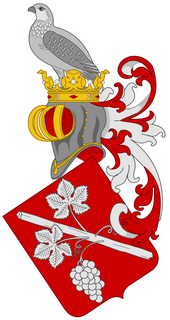
Kamenicky is a Czech noble family (uradel) originating from the Margraviate of Moravia. The family has been known since the 15th century. The name derives from the family's ancestral seat Kamenice in Moravia. Original seal from the year 1571 depicting the coat of arms is deposited in the Franzens museum in Brno. The coat of arms featuring a sloping wine tendril with two leaves and a bunch of grapes. One family branch got a majesty letter 1587 from the Holy Roman Emperor Rudolf II confirming the knighthood. In addition Kamenicky family is mentioned in the genealogist Bartholomeus Paprocký's work Diadochos published in Prague 1602.

The 'Dance Statute' established in 1521 the politically shaped town hall balls that the Nuremberg Magistrate held on certain days of the year, such as Sundays of the Lord's Carnival, or in honor of princes in the Old City Hall. Almost exclusively members of the families of the patriciate Nuremberg patriciate who were able to advise were invited. Advisable meant that the families were allowed to send up to two members to the ruling "Inner Council" of the city.

The patriciate of the imperial city of Nuremberg, the families entitled to the Inner Council, represented the actual center of power in Nuremberg until the French occupation in 1806.

The Schlüsselfelder von Kirchensittenbach were a patrician family of the Imperial City of Nuremberg, first mentioned in 1382. The Schlüsselfelder was in 1536, the last family in the Nuremberg Patriciate, which was listed in the Dance Statute of 1521 and constituted the ruling "Inner Council" of the city, in which the key fields were represented until they died out in 1709.









